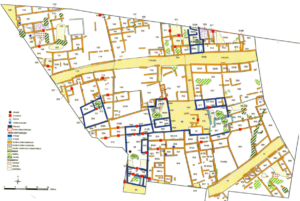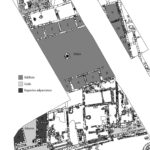
Souks

The commercial activity was developed in the souk or market, an essential space in the own identity of the Islamic city, regulated by the gentleman of the market (almotacen). Although they sometimes had places with access to the street, and easily identifiable, their archaeological distinction is often complex due to their perishable structures that clustered around a large plaza or street, often in the vicinity of mosques and baths. The market of the “dust”, dedicated to livestock or agricultural products, used to be placed in wide open spaces outside the walls.

Through various sources we know different bazaars of Islamic Cordoba, grouped according trades, such as the saddlers, perfumers, carpenters or drapers. The largest and most important was the large market, located in the tenth century in the west of the Alcazar and had a large number of stores dedicated to food, textiles or luxury goods. It suffered a great fire in 936 and disappeared definitively during the fitna (1009-1010), being looted and burned down.
During the Almohad stage, the commercial zone is located in the east of the Mosque, where a few years after the Castilian conquest there was a alcaiceria or market of luxury products (silks, jewellery, etc.), in an urban sector that, after the Christian conquest, will retain the name of the merchant activities in the name of the streets and squares.
In the interior and exterior of the city there were different alhondigas or inns where the merchants rested and traded, like the one documented recently in the western suburbs of the 10th century.
Bibliography
CHALMETA GENDRÓN, Pedro (1973): El señor del zoco en España. Edades Media y Moderna: contribución al estudio de la historia del mercado. Madrid.
CHALMETA GENDRÓN, Pedro (1967/1968): “El Kitāb fī ādāb al-ḥisba (libro del buen gobierno del zoco) de alSaqaṭī”, Al-Andalus, 32:1 pp. 125-162; 32:2, pp. 359-397; 33:1, pp. 143-195;33:2, pp. 367-464.
CLAPÉS SALMORAL, R. (2014‐2015): “La actividad comercial de Córdoba en época califal a través de un edificio hallado en el arrabal de Poniente”, Anales de Arqueología Cordobesa, 25‐26, pp. 225‐254.
CLÉMENT, F. (2006): “Catégories socioprofessionnelles et métiers urbains dans l’Espagne musulmane” en GÉAL, François (dir.): Regards sur al-Andalus (VIIIe- XVe siècle), pp. 95-128.
JIMÉNEZ CASTILLO, P.; NAVARRO PALAZÓN, J.; SÁNCHEZ GONZÁLEZ, M. J. (2006): “Sobre la formación del zoco. La excavación del solar de calle San Pedro de Murcia”, Memorias de Arqueología, 14, pp. 421-458.
TORRES BALBÁS, L. (1947): “Plazas, zocos y tiendas de las ciudades hispanomusulmanas”, Al-Andalus, 12.2, pp. 437-476.
ZANÓN, J. (1989): Topografía de la Córdoba Almohade a través de las fuentes árabes. Madrid.

